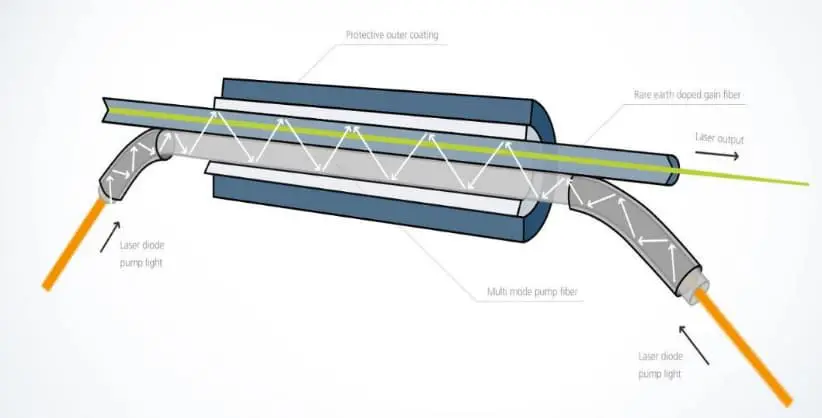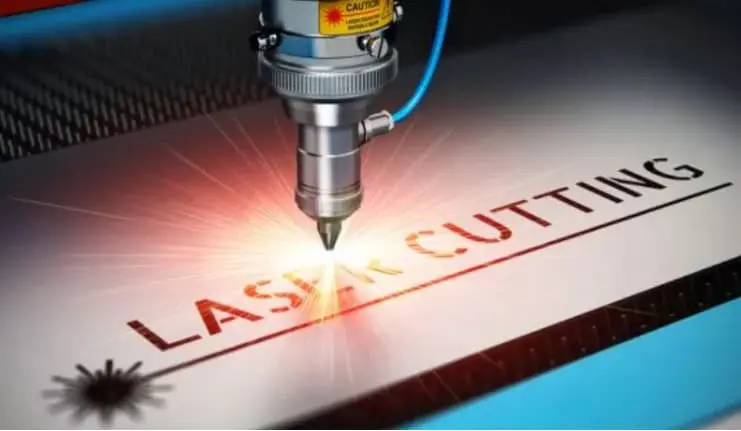Fiber laser vs CO2 laser is a common debate because the two technologies are easily available in the manufacturing sector. Some believe that CO2 lasers are better because of their capabilities while others say fiber lasers bring several innovations to the table which makes them a better alternative.
However, the right answer to the fiber laser vs CO2 debate depends on your application. No technology is better than the other. The best choice depends on your application and other factors like the required precision, material properties, and others.
The following text will take a look at what fiber and CO2 lasers bring to the table and try to address the fiber laser cutting vs CO2 laser cutting debate.
An Overview of Fiber Lasers
The fiber laser uses high-tech fiber optic components to deliver an intense beam of light that can laser cut different materials with ease. They are the best choice for metal processes like etching, annealing, and engraving.
The overall concept and process of fiber lasers are extremely simple and versatile. The term doesn’t encompass the light source, which is different than CO2 lasers. The focus is on the delivery mechanism that uses fiber optics to concentrate all the light to a single point. The working mechanism of fiber laser also reflects this simplicity. The fiber optic in the laser cutter receives the light and amplifies it to the laser pointer.

The cutting head uses CNC for precision and accuracy. Moreover, the fiber optic has a series of additional focal lenses that further enhance the overall accuracy of the whole system. Finally, the laser cutter uses either NO2 or O2 as a purging gas to facilitate the cutting process.
When it comes to laser cutting, operational costs are a significant consideration. Fiber lasers, however, don’t have such maintenance requirements. This means that the overall costs of operating and maintaining the machinery are quite low. However, the initial capital requirements of purchasing a fiber laser are quite high, which makes it unfeasible for small or medium businesses.
An Overview of CO2 Lasers
CO2 lasers use a combination of a resonator, purging gases, and high-velocity blowers to create high-powered light particles that collide with each other to deliver high-intensity light that can cut through thicker materials with relative ease.
Contrary to the fiber laser, CO2 lasers have a beam path delivery system that initially operates a little differently by using the process of reflection and refocusing rather than focal lenses like fiber lasers.

Generally, CO2 lasers tend to be more cost-effective than their fiber counterparts. However, the lower initial cost doesn’t mean that it’s more economical. CO2 lasers consume a lot of power and that can result in very high operating costs.
Fiber Laser vs CO2 Laser: Head-On-Head Comparison
CO2 vs fiber laser is a significant debate that requires careful consideration of several factors. You need to consider the technical factors like the energy source and the light wavelength to the process parameters like the cutting speeds and precision. Here’s a head-on-head comparison of the most important factors to address all the questions you might have about fiber vs CO2 lasers.
1 – Energy Source
Fiber lasers use LEDs to emit light that is then concentrated by the fiber optical lenses that amplify the light to deliver results. On the other hand, CO2 lasers stimulate a mixture of gases like CO2, N2, Xe, and others to create waves that intensify to cut through different objects easily.
2 – Power Consumption
Fiber lasers are extremely efficient. In comparison to their CO2 counterparts, fiber lasers consume 30% less power, which means that they can get the job done quicker and with fewer resources.
3 – The Wavelength of Light
Both CO2 and fiber lasers operate in the infrared spectrum. Generally, a CO2 laser emits a wavelength of 10,600 nm while a fiber laser emits in the range of 780 to 2200 nm.

4 – Cutting speeds
When it comes to thinner workpieces, fiber lasers offer much better cutting speeds. In general terms, a 2 KW fiber laser will cut as fast as a 5- or 6-KW CO2 laser. The main reason behind this is the power density of fiber lasers. The optical system efficiently focuses a lot of power at a single spot and offers a much better cutting speed than CO2 lasers.
5 – Cut Precision
If you talk about the exact stability and precision, then fiber lasers will be better. However, precision has another dimension in the manufacturing sector and it deals with the smoothness of the edges. In that regard, CO2 lasers perform much better so the actual choice depends on your preferences.
6 – Cutting Range
Fiber laser machines have an overall cutting range of 13mm when it comes to metal sheets. There are some high-powered versions that can cut softer materials like Aluminum up to 30mm, but those versions are extremely expensive.
CO2 lasers, on the other hand, are only limited by their power levels. Depending on the wattage, the CO2 laser will cut through different widths easily.
7 – System Configuration
Compared to a CO2 laser, fiber lasers and extremely simplistic and don’t require any intricate systems, which makes them easier to operate and learn.
8 – Investment Costs
The initial investment required for the CO2 laser and fiber laser has a wide difference. Fiber lasers are quite expensive because only a few brands manufacture these machines and the technology is fairly new. CO2 lasers, on the other hand, have been around for a while, so the machines you need for them are not as expensive as the other option.
Advantages and Disadvantages of Fiber vs CO2 Laser
While talking about fiber vs CO2 laser, it’s integral to consider the advantages and disadvantages of both technologies.
Advantages and Disadvantages of Fiber Lasers
Fiber lasers have several advantages because of their innovative nature and versatility. Here are a few of them:
- Better Quality: The optical fiber technology provides more stability and precision that gives you a smaller cutting line and stable performance for all laser cutting product designs.
- Faster and Reliable Cutting: Fiber lasers are also famous because of their excellent reliability and the ability to process things more quickly because of their high intensity.
- High Efficiency: Fiber lasers have about 30% higher electro-conversion efficiency, which means that you can do more with less power.
- Simple: When compared with other alternatives, operating fiber laser is quite straightforward and requires minimal training.
- Low Operating Costs: Because of its efficiency, simplicity, and low maintenance costs, managing a fiber laser is more cost-effective.
The aforementioned advantages are excellent. However, there are two sides to every coin. Fiber lasers have several limitations as well. Here are a few most important ones:
- High Purchasing Cost: While the operating costs are low, the overall investment you need to purchase a fiber laser is quite high.
- Gas Consumption: Fiber lasers use NO2 or O2 gas for purging and tend to consume a lot of gas. This can be a hassle for the operators.
- Difficulty with Some Materials: Fiber lasers have some difficulty in processing reflective materials like Aluminum and Copper. Moreover, fiber laser is also unable to deal with some thicker samples more effectively.
Advantages and Disadvantages of CO2 Lasers
CO2 lasers have several advantages that make them suitable for a variety of applications. Here are some of the advantages:
- Better Finish: CO2 lasers deliver a better finish, especially with stainless steel and aluminum workpieces.
- More Flexibility: CO2 lasers are quite versatile and can handle metal, non-metal, and other composite materials without any tweaking.
- Technological Edge: CO2 lasers have been around for a long while and there are many experts in the market who know how to deal with the common issues related to CO2 lasers.
CO2 lasers have several limitations as well. Here are a few of its main disadvantages:
- High Operating and Maintenance Costs: CO2 lasers have a lot of maintenance requirements that need both time and resources. The beam path delivery system has a lot of components that require constant maintenance and consume a lot of power as well. All of this drives up the overall cost of operating the lasers quite significantly.
- Maintenance Issues: CO2 lasers require prim and proper conditions for operations and have several requirements that can disrupt the regular processes of the industry.
- Slow Speed: When compared with fiber lasers, CO2 lasers require a lot of time to complete their operations. When it comes to thinner parts, CO2 lasers can’t compete at all. Consider the example of a 4KW CO2 laser with a mild steel workpiece and N2 purging gas. This laser would have a cutting speed of 260 IPM while a fiber laser of the same power would have a cutting speed of 1400 IPM.
Things to Consider When Choosing Between Fiber Laser and CO2
The main purpose of the fiber laser vs CO2 laser is to determine which type of technology you should go for while working on your project. During that phase, you should keep in mind the following conditions and base your choice on them. Here they are.
Materials to Cut
The material plays an important role in determining the kind of machine you should use. Generally, fiber lasers are an excellent choice for thin metal sheets (for example; 2mm copper, 3mm stainless steel, and 6mm carbon steel for a 700W laser) because of their speed and intensity. They can also handle other materials as well.
CO2 lasers, on the other hand, come with the capability of handling thicker workpieces easily. The actual cutting capabilities of the laser cutter depend on the power of the laser. Generally, experts recommend using CO2 lasers above 5mm because of the higher stability and straighter line. You can also deal with other non-metals with a CO2 laser as well.
Applications
Apart from cutting, lasers have other applications like engraving and etching. Both CO2 and fiber lasers are excellent choices for the job. However, fiber lasers are naturally better because they are faster, more innovative, and cheaper to operate.

Production Rate
Depending on your application, you’ll have to deal with the issue of the production rate as well. For faster processing, fiber lasers are the best choice. CO2 lasers work well too, but they are inherently slow. However, that is only the case with thinner workpieces. For thicker parts, you’ll have no choice but to use a CO2 laser.
Purchase Budget
Laser cutting costs are high, and one part of the overall costs are related to the amount you need to purchase the setup. CO2 lasers are more cost-effective because the technology is older and more readily available with so many manufacturers in the market.
On the other hand, the manufacturers of fiber lasers are far and few, and the technology is relatively new as well. This means that you’ll have to spend an exuberant amount on purchasing the fiber laser. However, the high initial cost will be worth it because of the low operational requirements of the fiber laser.
Maintenance
Depending on the kind of setup you are operating with, you might not have enough time for equipment that requires a lot of maintenance even if they are good enough for the job. In the fiber laser vs CO2 laser debate, the maintenance requirement is a huge issue because many machine shops have a lot of orders and can’t afford to spend too much time on maintenance.
In this case, fiber lasers perform best. The optical system doesn’t have a lot of maintenance requirements and can operate in many conditions. On the other hand, CO2 lasers have tough maintenance requirements and perform in pristine conditions only, which makes operations harder.
Safety
Laser cutters are dangerous. Both CO2 lasers and fiber lasers emit extremely harmful radiations that can cause permanent damage, especially in the eye, if you are not careful. That’s why it’s so important to always wear protective equipment while dealing with laser cutters.
While both fiber and CO2 lasers are dangerous, fiber lasers generally come with protective housing that eliminates the safety hazard. If you are purchasing one with such features, then there is no safety hazard for you. Unfortunately, CO2 lasers don’t come with a 100% risk-free option, so you’ll have to use protective equipment for the best results.
Krrass: The Best Choice for All Laser Cutting Manufacturer
When you consider the overall costs of purchasing, maintaining, and operating a laser cutting setup, a sheet metal fabrication service – laser cutting would seem like the best option. Krrass has a tremendous reputation in the market because of its focus on consistency and quality at the most competitive price.
Be it sheet metal cutting or any other application, our team of experts has the right combination of industry knowledge and the latest tool to provide you with the best products and services in the market. Moreover, we set ourselves apart with our advanced system that’s completely online. Just let us know your product needs, request A Quote and get started with the process.
Make a request and Get Started Today
Get Instant Quote
Conclusion
When it comes to laser cutting fiber laser vs CO2 laser, it is an old and common debate. There is obviously no clear winner because the right technology for you depends on the application, material, and other factors.
However, the general rule of thumb states that fiber lasers are the best choice if you regularly deal with thinner parts and need faster results. For thicker parts and dealing with other nonmetals as well, CO2 lasers are a better choice.
Additionally, you should also consider the costs as well because there is a high discrepancy between the two options. Fiber lasers are extremely expensive to purchase but cheaper to operate while CO2 lasers are the exact opposite of that because of their power consumption and maintenance requirements.
Learn more about our products, please visit and subscribe to our Youtube channel





